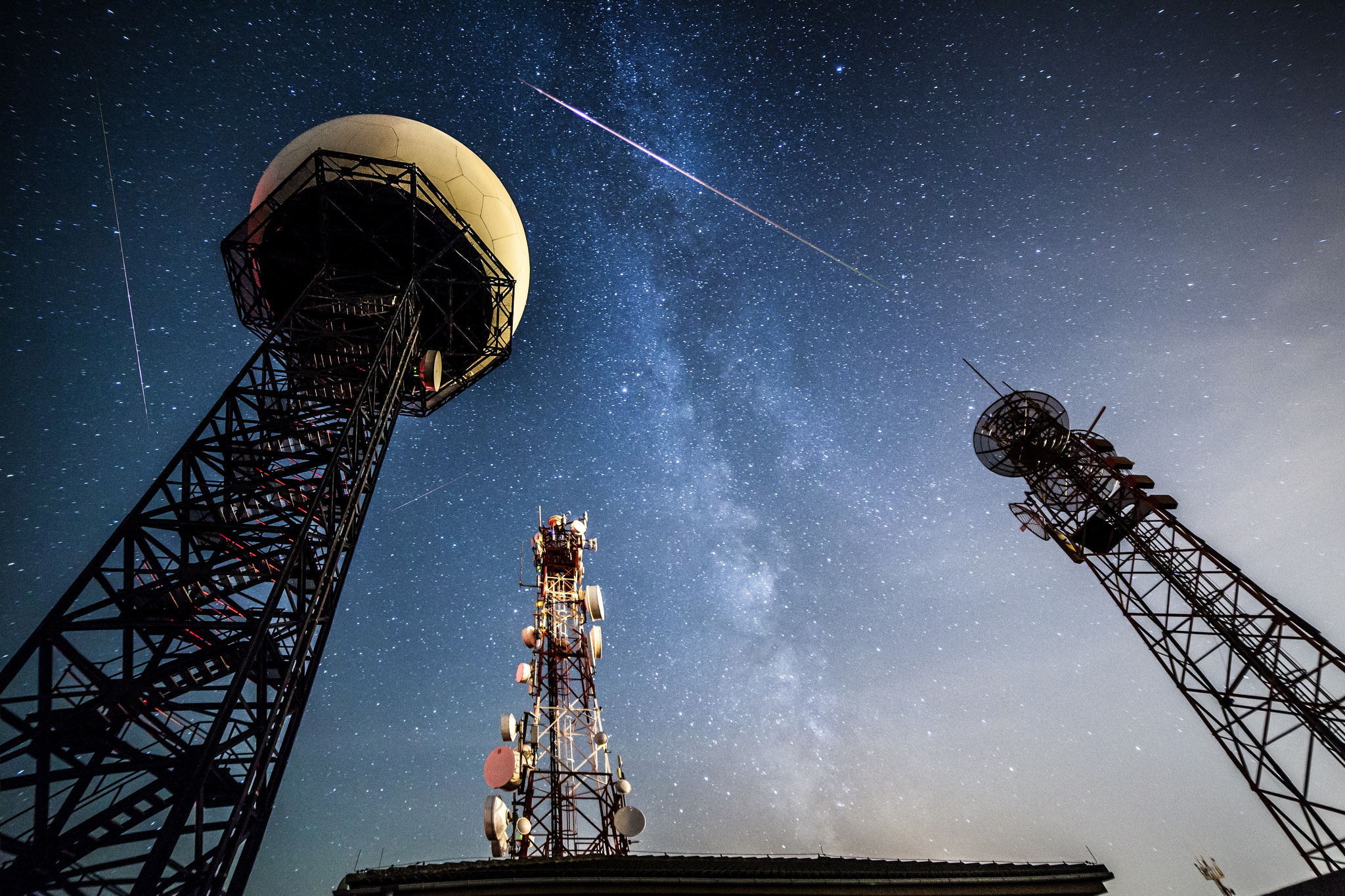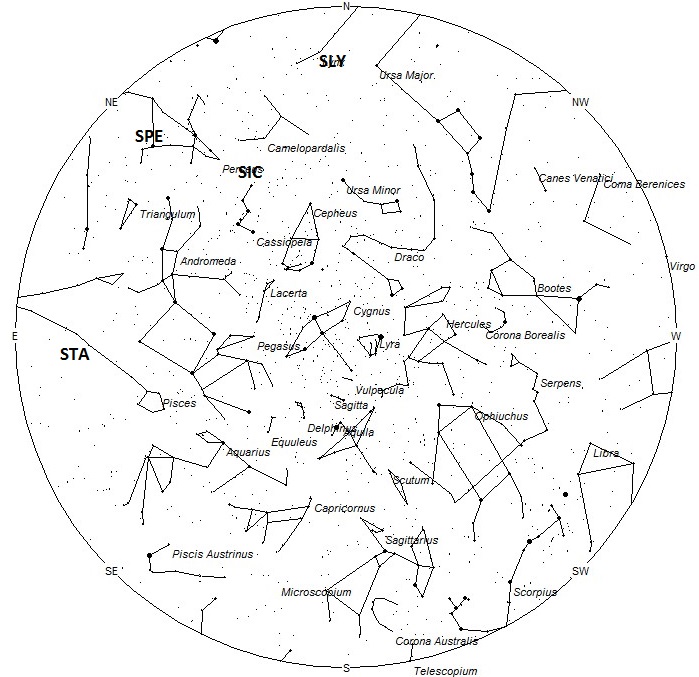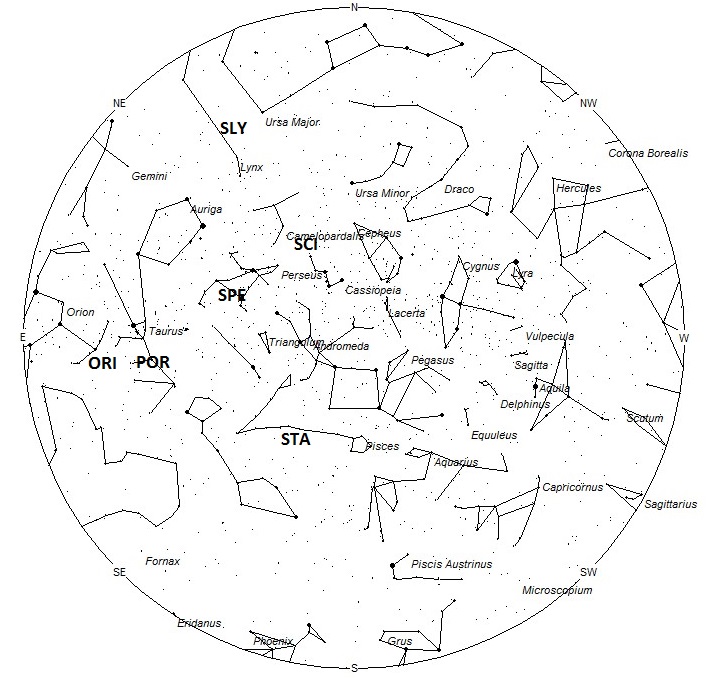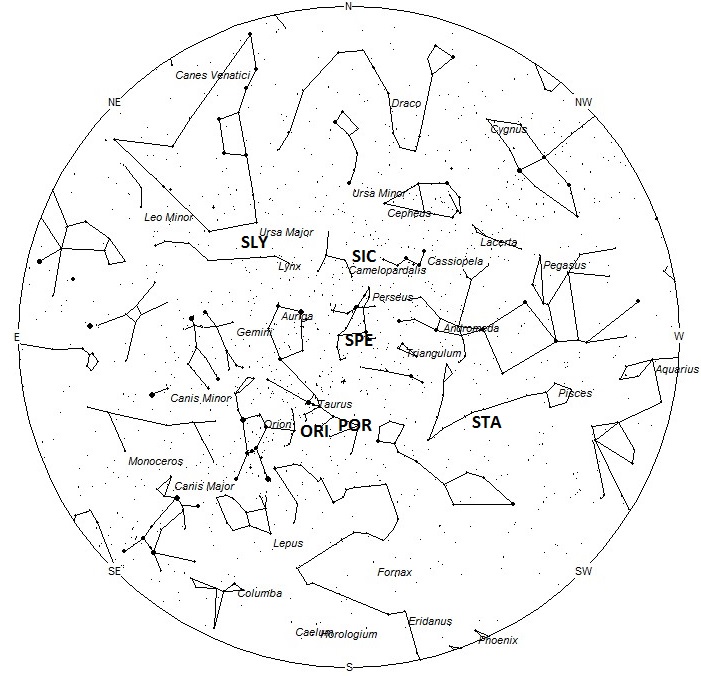
2 Perseid Meteors over Mallorca, Spain – August 13th, 2015 – ©Andrés Nieto Porras
During this period the moon reaches its new phase on Sunday September 13th. On that date the moon will be located near the sun and will be invisible at night. Later during this period the moon will emerge into the evening sky as a waxing crescent but will not interfere with meteor observing, especially during the more active morning hours. The estimated total hourly meteor rates for evening observers this week is near 4 as seen from mid-northern latitudes (45N) and 3 as seen from tropical southern locations (25S). For morning observers the estimated total hourly rates should be near 18 as seen from mid-northern latitudes (45N) and 12 as seen from tropical southern locations (25S). The actual rates will also depend on factors such as personal light and motion perception, local weather conditions, alertness and experience in watching meteor activity. Note that the hourly rates listed below are estimates as viewed from dark sky sites away from urban light sources. Observers viewing from urban areas will see less activity as only the brightest meteors will be visible from such locations.
The radiant (the area of the sky where meteors appear to shoot from) positions and rates listed below are exact for Saturday night/Sunday morning September 12/13. These positions do not change greatly day to day so the listed coordinates may be used during this entire period. Most star atlases (available at science stores and planetariums) will provide maps with grid lines of the celestial coordinates so that you may find out exactly where these positions are located in the sky. A planisphere or computer planetarium program is also useful in showing the sky at any time of night on any date of the year. Activity from each radiant is best seen when it is positioned highest in the sky, either due north or south along the meridian, depending on your latitude. It must be remembered that meteor activity is rarely seen at the radiant position. Rather they shoot outwards from the radiant so it is best to center your field of view so that the radiant lies at the edge and not the center. Viewing there will allow you to easily trace the path of each meteor back to the radiant (if it is a shower member) or in another direction if it is a sporadic. Meteor activity is not seen from radiants that are located below the horizon. The positions below are listed in a west to east manner in order of right ascension (celestial longitude). The positions listed first are located further west therefore are accessible earlier in the night while those listed further down the list rise later in the night.
These sources of meteoric activity are expected to be active this week.
We are now encountering debris from comet 2P/Encke, which has a radiant superimposed upon the anthelion radiant. Since it has been shown that meteors from 2P/Encke are more numerous we shall recognize this activity as the Southern Taurids (STA) until December 5th, when the Earth no longer encounters these particles. The maximum was once thought to occur in early November when the radiant was located in Taurus. Video studies have shown that the peak usually occurs near October 10th but that there is also a period of enhancement during the last week of October and the first week of November, when the Northern Taurids are also active. The center of the large radiant is currently located at 00:52 (013) +04. This position lies in southern Pisces, 2 degrees south of the fourth magnitude star Delta Piscium. These meteors may be seen all night long but the radiant is best placed near 0200 local daylight time (LDT) when it lies on the meridian and is located highest in the sky. Rates at this time should be near 2 per hour regardless of your location. With an entry velocity of 29 km/sec., the average Southern Taurid meteor would be of slow velocity.
A recently discovered shower with a short duration of only 7 nights are the September Iota Cassiopeiids (SIC). These meteors were discovered by Juergen Rendtel and Sirko Molau while searching for radiants among the data of the IMO video network. This shower is active from September 10th through the 16th with maximum activity occurring on the 15th. At maximum, the radiant lies at 03:04 (046) +64. This position lies in eastern Cassiopeia some 7 degrees east of the 3rd magnitude star known as Segin (Epsilon Cassiopeiae). Rates at maximum are not expected to exceed 1 per hour. Due to the high northern declination (celestial latitude) this shower is poorly seen from the southern hemisphere. With an entry velocity of 55 km/sec., the average September Iota Cassiopeiid meteor would be of swift velocity. This shower may be an outlying member of the Perseus-Auriga complex active this time of year.
The September Epsilon Perseids (SPE) are just past their peak but still producing activity from a radiant located at 03:16 (049) +40. This position lies in southwestern Perseus, just east of the famous eclipsing variable star known as Algol (Beta Persei). The radiant is best placed near 0500 LDT, when it lies highest above the horizon. Hourly rates are expected to be near 2 per hour as seen from the northern hemisphere and less than 1 as seen south of the equator. With an entry velocity of 66 km/sec., most activity from this radiant would be swift.
The September Pi Orionids (POR) are a short duration shower discovered by John Greaves during his studies of video data from the SonotaCo Network in Japan. This shower is only active from September 16-20 with no discernible maximum. The average position of the radiant is 04:08 (062) +06 which places the radiant in southern Taurus between the 4th magnitude stars Nu and Upsilon Tauri. This position is also close to that of the Orionid radiant so care must be taken to differentiate between the two sources. Activity is expected to be low, with rates most likely less than 1 per hour. This area of the sky is best placed in the sky during the last hour before dawn, when it lies highest above the horizon in a dark sky. These meteor may be seen equally well from both hemispheres. With an entry velocity of 66 km/sec., most activity from this radiant would be swift.
You may be surprised to see the Orionids (ORI) as an active radiant this time of year, but there is clear evidence from the IMO database that this shower is active long before its October 22nd maximum. In fact it is in the top four most active radiants throughout September. Expected rates this week are near 2 per hour no matter your location. This radiant is currently located at 04:44 (071) +03, which places it on the Taurus/Orion border, 4 degrees southwest of the 4th magnitude star known as Pi 3 Orionis. This area of the sky is best placed in the sky during the last hour before dawn, when it lies highest above the horizon in a dark sky. With an entry velocity of 67 km/sec., most activity from this radiant would be of swift speed.
The September Lyncids (SLY) are active from a radiant located at 07:36 (114) +59. This position lies in extreme northern Lynx some 12 degrees west of the 4th magnitude star known as Omicron Ursae Majoris. This area of the sky is best placed in the sky during the last hour before dawn, when it lies highest above the horizon in a dark sky. Hourly rates of only 1 or less are expected to be seen from the northern hemisphere. Due to the high northern declination this activity is not well seen south of the equator. With an entry velocity of 60 km/sec., most activity from this radiant would be of swift speed.
As seen from the mid-northern hemisphere (45N) one would expect to see approximately 11 sporadic meteors per hour during the last hour before dawn as seen from rural observing sites. Evening rates would be near 3 per hour. As seen from the tropical southern latitudes (25S), morning rates would be near 7 per hour as seen from rural observing sites and 2 per hour during the evening hours. Locations between these two extremes would see activity between the listed figures.
The table below presents a list of radiants that are expected to be active this week. Rates and positions are exact for Saturday night/Sunday morning except where noted in the shower descriptions.
| SHOWER | DATE OF MAXIMUM ACTIVITY | CELESTIAL POSITION | ENTRY VELOCITY | CULMINATION | HOURLY RATE | CLASS |
| RA (RA in Deg.) DEC | Km/Sec | Local Daylight Saving Time | North-South | |||
| Southern Taurids (STA) | Oct 10 | 00:52 (013) +04 | 29 | 02:00 | 2 – 2 | II |
| September Iota Cassiopeiids (SIC) | Sep 15 | 03:04 (046) +64 | 55 | 04:00 | <1 – <1 | IV |
| September Epsilon Perseids (SPE) | Sep 10 | 03:16 (049) +40 | 65 | 05:00 | 2 – <1 | II |
| September Pi Orionids (POR) | Sep 18 | 04:08 (062) +06 | 66 | 06:00 | <1 – <1 | IV |
| Orionids (ORI) | Oct 22 | 04:44 (071) +03 | 67 | 06:00 | 2 – 2 | I |
| September Lyncids (SLY) | Sep 09 | 07:36 (114) +59 | 60 | 09:00 | <1 – <1 | IV |
 American Meteor Society
American Meteor Society



The night of September 9th I was in Scotland near Inverness. We were outside because someone had seen the Northern Lights briefly. About 9:30 ish looking Northwards there was the most amazing meteorite travelling west to east, glowing yellow, much larger than usual and it slowed down rapidly, visible for several seconds rather than a quick flash. Then bits started to break off and it went out of sight. The best I have seen in my life.
Last night, September 17, 2015 at approximately 8:15pm EST I observed the largest meteor fireball I have ever witnessed. It was easily viewable for the several seconds it took to burnout overhead as it also dropped fragments in it’s wake. It passed almost directly overhead, but slightly to the south, traveling from East to West over my location in Hillsborough, NJ. It was a reall treat to observe and witnessed quite by accident. I went out later to watch for more however observed nothing further. I am wondering if anyone else observed the same event.